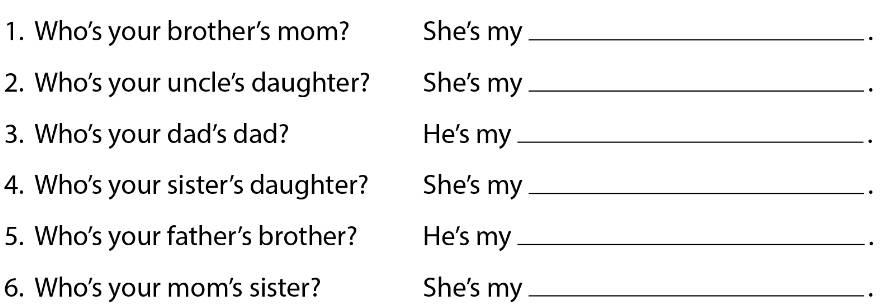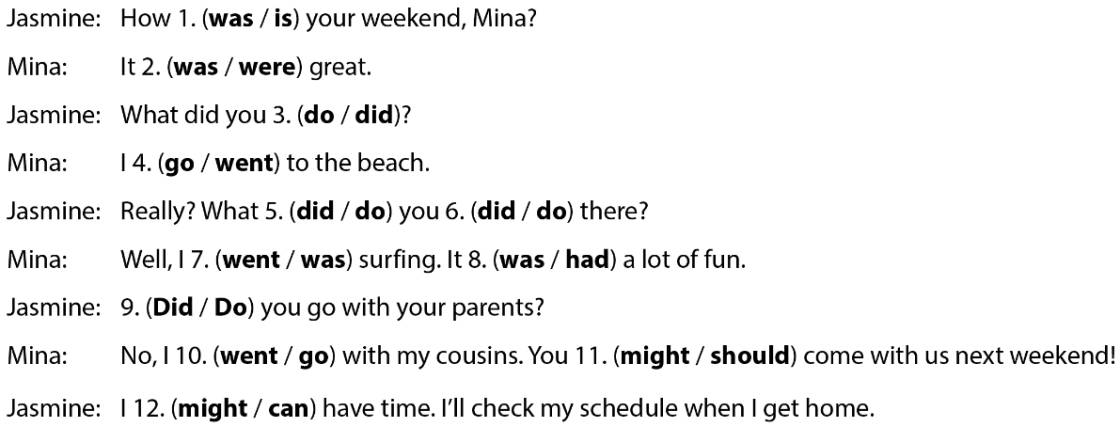
Hãy nhập câu hỏi của bạn vào đây, nếu là tài khoản VIP, bạn sẽ được ưu tiên trả lời.


1. PE
2. geography
3. maths
4. science
5. ICT
6. Spanish
7. history
8. English
9. art
1. Are you good at PE?
(Bạn có giỏi môn thể dục không?)
2. When’s our next geography exam?
(Khi nào thì kỳ thi Địa lý tiếp theo của chúng ta?)
3. Are you a maths genius?
(Bạn có phải là một thiên tài toán học không?)
4. Is your science notebook organised?
(Sổ ghi chép khoa học của bạn có được sắp xếp không?)
5. Have we got an ICT class tomorrow?
(Ngày mai chúng ta có tiết học Công nghệ thông tin và truyền thông không?)
6. Do you study other languages, like Spanish?
(Bạn có học các ngôn ngữ khác, như tiếng Tây Ban Nha không?)
7. Have you got history homework today?
(Hôm nay bạn có bài tập Lịch sử không?)
8. Do you think that our English textbook is interesting?
(Bạn có nghĩ sách giáo khoa tiếng Anh của chúng ta thú vị không?)
9. How many art teachers are there in the school?
(Có bao nhiêu giáo viên mỹ thuật trong trường?)

Sounds like s in drinks (Âm s như trong drinks) | Sounds likes s in bananas (Âm s như trong bananas) | Sounds like s in glasses (Âm s như trong glasses) |
- chips - grapes - desserts - likes | - vegetables | - peaches - oranges - slices |

1. Ben is at home.
(Ben đang ở đâu? – Ben đang ở nhà.)
2. He is studying.
(Bạn ấy đang làm gì? – Bạn ấy đang học.)
Tạm dịch văn bản:
Tôi vẫn có thể học
Hầu hết trẻ em từ 5 đến 18 tuổi ở Anh phải đến trường. Nhưng trường hợp của tôi thì khác. Tôi chơi quần vợt và tôi phải luyện tập rất nhiều, và tôi thường đến các quốc gia khác để thi đấu trong các giải đấu. Làm thế nào tôi vẫn có thể học được? May mắn thay, học tập kỹ thuật số giúp tôi.
Khi tôi nghỉ học, tôi tham gia các khóa học trực tuyến. Máy tính giúp tôi giải các môn học và tôi có thể học với tốc độ của riêng mình. Khi không có giải đấu, tôi trở lại trường và tôi có thể làm các bài kiểm tra một cách dễ dàng. Bạn bè của tôi cũng giúp tôi nếu tôi có bất kỳ vấn đề nào.
Cách học mới này giúp tôi cảm thấy vui vẻ và theo kịp bạn bè. Tôi vẫn có thể học khi tôi không ở trường. Đó là lý do tại sao học kỹ thuật số ngày càng trở nên phổ biến.
* theo kịp: làm bất cứ điều gì cần thiết để duy trì mức độ hoặc bằng với ai đó hoặc điều gì đó

1. Can elephants (1) hear with their ears and their feet?
(Voi có nghe được bằng tai và bằng chân không?)
2. How big can a gorilla (2) grow?
(Một con khỉ đột có thể phát triển lớn đến mức nào?)
3. Some scorpions are dangerous. Can a scorpion (3) kill a human?
(Một số loài bọ cạp rất nguy hiểm. Bọ cạp có thể giết người không?)
4. Camels don't (4) drink a lot of water. How many months can a camel (5) survive without water?
(Lạc đà không uống nhiều nước. Lạc đà có thể sống được bao nhiêu tháng nếu không có nước?)
5. How far can an eagle (6) see? It can (7) see a small animal from a distance of
(Đại bàng có thể nhìn thấy bao xa? Nó có thể nhìn thấy một con vật nhỏ từ khoảng cách…)
6. Ostriches can't (8) fly but how fast can they (9) run?
(Đà điểu không thể bay nhưng chúng chạy nhanh đến mức nào?)

* Interviewer: (Người phỏng vấn)
1. I've got a few questions for you.
4. One more question.
6. Thanks for your time.
* Pop star: (Ngôi sao nhạc pop)
2. Sure, go ahead.
3. Good question!
5. That's a difficult one.

1. was 2.was 3. do 4. went 5. did 6. do
7. went 8. had 9. Did 10. went 11. should 12. Might
Hướng dẫn dịch
Jasmine: Cuối tuần của cậu như thế nào vậy Mina?
Mina: Nó rất là tuyệt.
Jasmine: Cậu đã làm gì vậy?
Mina: Tớ đã đi đến bãi biển.
Jasmine: Thật á? Cậu đã làm gì ở đấy?
Mina: Ừ, tớ đi lướt ván. Nó thật sự rất là vui.
Jasmine: Cậu có đi cùng với bố mẹ không?
Mina: Không, tớ đi với họ hàng của mình. Bạn nên đi với bọn tớ vào tuần sau.
Jasmine: Tớ có thể có thời gian. Tớ sẽ về kiểm tra lịch khi tớ về nhà.

1 hot
2 summer
3 June to September
4 November to March
5 cold
6 cool and dry
Hướng dẫn dịch
Hunter: Thời tiết nơi bạn sống như thế nào vậy?
Sarah: Ừ, ở Perth thì thời tiết luôn luôn nóng vào tháng một và tháng 2. Thời điểm đó là mùa hè ở đây.
Hunter: Thật á? Vậy khi nào là mùa đông ở Australia?
Sarah: Mùa đông ở Australia là từ tháng 6 đến tháng 9.
Hunter: Ở Ottawa. Mùa đông từ tháng 11 đến tháng 3. Lúc đó trời luôn luôn lạnh. Mùa đông thì dài và có tuyết.
Sarah: Mùa hè trời có nóng không?
Hunter: Nó thỉnh thoảng khá nóng, nhưng nó thường mát và khô.

1. How much is/ It’s
2. How much is/ It’s
3. How much is/ It’s/ It’s
4. How much are/ They’re
Hướng dẫn dịch
1.
A: Cái ví này bao nhiêu tiền vậy?
B: Nó có giá $12
2.
A: Cái đồng hồ kia bao nhiêu tiền vậy?
B: Nó có giá $50
3.
A: Cái mũ này bao nhiêu tiền vậy?
B: Nó khá là rẻ. Nó có giá $10
4.
A: Những quyển sách kia bao nhiêu tiền vậy?
B: Chúng có giá $12







1 mom
2 cousin
3 grandfather
4 niece
5 uncle
6 aunt
1. Who's your brother's mom?
(Mẹ của anh em trai của em là ai?)
2. Who's your uncle's daughter?
(Con gái của chú/ bác của em là ai?)
3. Who's your dad's dad?
(Bố của bố của em là ai?)
4. Who's your sister's daughter?
(Con gái của chị/ em gái của em là ai?)
5. Who's your father's brother?
(Anh/ em trai của bố/ cha của em là ai?)
6. Who's your mom's sister?
(Chị / em gái của em là ai?)
She's my mom.
(Đấy là mẹ của em.)
She's my cousin.
(Đấy là chị em họ của em)
He's my grandfather.
(Đấy là ông nội của em.)
She's my niece.
(Đấy là cháu gái của em.)
He's my uncle.
(Đấy là chú/ bác của em.)
She's my aunt.
(Đấy là dì/ già của em.)